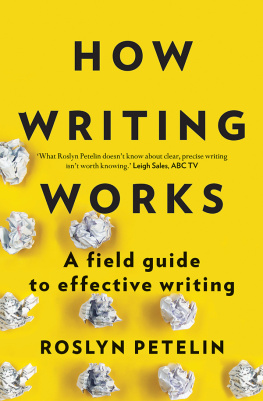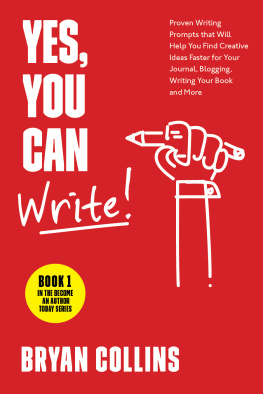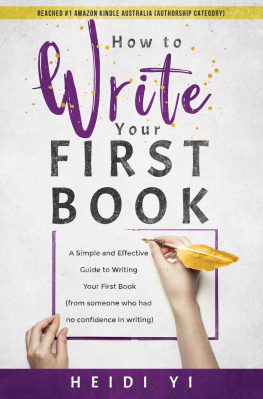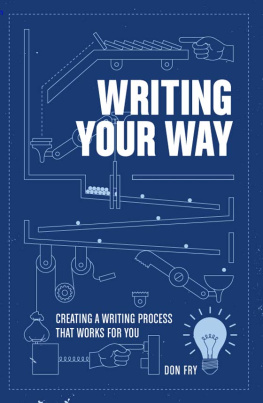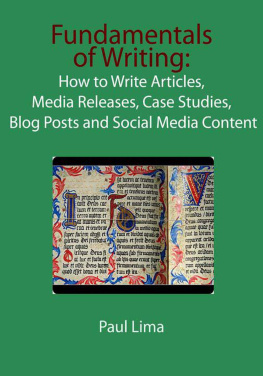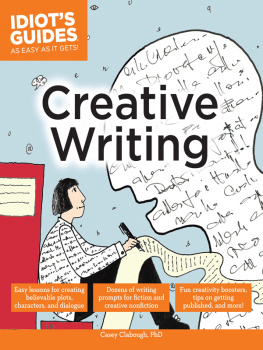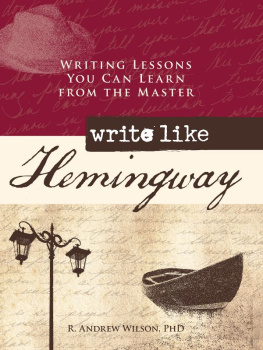First published in 2016
Copyright Roslyn Petelin 2016
All rights reserved. No part of this book may be reproduced or transmitted in any form or by any means, electronic or mechanical, including photocopying, recording or by any information storage and retrieval system, without prior permission in writing from the publisher. The Australian Copyright Act 1968 (the Act) allows a maximum of one chapter or 10 per cent of this book, whichever is the greater, to be photocopied by any educational institution for its educational purposes provided that the educational institution (or body that administers it) has given a remuneration notice to the Copyright Agency (Australia) under the Act.
Allen & Unwin
83 Alexander Street
Crows Nest NSW 2065
Australia
Phone:(61 2) 8425 0100
Email:
Web:www.allenandunwin.com
Cataloguing-in-Publication details are available from the National Library of Australia
www.trove.nla.gov.au
ISBN 9781925266917
eISBN 9781952535321
Set by Bookhouse, Sydney
Cover design by Design by Committee
This book is dedicated to my dear friend Professor Linda K. Fuller, of Worcester State University, Massachusetts, whom I can always rely on to produce perfect prose.
Contents
Renowned American writing educator Peter Elbow dedicated his book Writing Without Teachers (1973) to those people who actually use itnot just read it. I cant endorse his sentiment strongly enough. Id love everyone who reads this book to use it by putting into practice its heuristics (from the Greek word to discover) and strategies in their own writing. Whether your writing is already reasonably good or less than good, following the books advice and implementing its strategies will exponentially enhance your writing self-efficacy (your confidence and competence). At the end of each chapter there are practical activities, which one of the student readers of an earlier draft of this book said were their favourite parts of the book.
Whether you are a student or a workplace writer, or a creative writer, whether writing is your vocation, your avocation, or both, this book aims to provide you with a substantial and engaging introduction to contemporary writing in plain language with its accelerating demands for succinct and coherent writing. Following this books advice will enable you to gain control over your words so that you can write the concise, lucid, nuanced, and compelling prose that is so valued in universities and in the professions.
The book will develop your understanding and use of generic structures in academic and workplace contexts and help you to survive and thrive in the writing-reliant arenas of the 21st century. It will help you to use the right words in the right order in the right places at the right time for the right reasons.
The book introduces the core concepts of writing and reading, then follows with a discussion of writing at the word, sentence (including punctuation), and paragraph level. It then covers the structure and design of documents in the most common academic and workplace genres, followed by a chapter on digital writing and a concluding chapter on revising, editing, and proofreading. The book also contains a wide range of resources, with references to useful print and online sites for further reading and learning. One of the student readers of an earlier draft of the book told me to remove the instances of Google it! that I had inserted here and there, because she said that millennials wouldnt need that advice. I have therefore removed the instruction to google, and I know that many non-millennials wont need Google it suggestions but will also spontaneously turn to the glorious resources of the internet to explore rich pickings alluded to in the book.
Although I have written this book primarily for university and workplace writers, I firmly believe that much of the material and advice will be valuable for creative writers, who also need to be their own best editors. Some of the content in this book is based on material that I wrote for Professional Communication: Principles and applications by Peter Putnis and Roslyn Petelin (Prentice Hall, 2nd edition, 1999). I have also adapted a small amount of the material that I wrote and which was published in The Professional Writing Guide: Writing well and knowing why by Roslyn Petelin and Marsha Durham (Longman Professional, 1992). Many of the examples have been drawn from my work in consulting about writing and editing to the corporate sphere.
I have made every effort to locate sources and copyright holders of other original material reproduced in the book, but if there are any errors or omissions, I will be pleased to insert the appropriate credit in any subsequent edition.
Roslyn Petelin
You have to let words talk to words.
KEN MACRORIE
Before writing was invented, speaking was the main mode of communication. And while oralitya term derived from the Latin word for the mouthwas central to culture before the invention of writing, writing has become absolutely central to contemporary culture. These days, everyones a writerin social, educational, and professional spaces (Pullum, 2014; Yagoda, 2013). Writing is a mass daily experience (Brandt, 2015); journalist Clive Thompson (quoted in Brandt) claims that, worldwide, people produce 3.6 trillion words on the Web every day.
In a 2012 presentation on YouTube, workplace-writing researcher Professor Deborah Brandt describes how, over the last 50 or 60 years, the world economy has shifted from a base in manufacturing goods to a base in manufacturing services, that is, knowledge, ideas, data, and information. She says as a consequence of this shift, writing has become the work of our time. Living in the twenty-first century entails living in a service-oriented information societyknown as the knowledge economy. Writing is at the heart of this knowledge economy: it is ubiquitous, demanding ever greater levels of verbal sophistication.
The rise and rise of the internet in our digital era has dramatically upped the ante. Employers want graduates who are problem solversvariously called gold-collar workers, knowledge workers, and information architectsthat is, graduates who can research, analyse, write, and edit, and who are critical and creative thinkers with technological competence and design sensibility.
Contemporary government, business, education, and industry rely on writing. I can think of no disciplines or professions that arent critically reliant on the researching, writing, and editing nexus. A recent research project by the Society for Human Resource Management reported that two crucial skills lacking in US college graduates both involve... writing (Nguyen, 2015).
Writing is at the centre of all disciplines and professions. We are often judged on the quality of our writing, so its essential to strive for professionalism. Youll need to write well to succeed in your studies and to have a great career path in whatever profession you enter. The workplace requires a strong grasp of words, grammar, and sentence structurewhat is widely regarded as Standard English. Standard English is rather an elastic term, but English holds its place as the language of power and prestige in much of the world.
Writing is a process in which thinking and learning take place. This process is known as the writingthinkinglearning connection. Its a process that results in a communicative product that conforms to grammatical, syntactical, mechanical, and genre conventions. Importantly, writing also performs recognisable social functions that have increased in importance with the rise of social media. We live in what has been called a participatory society, where social media consistently provides us with opportunities to interact in global conversations.

